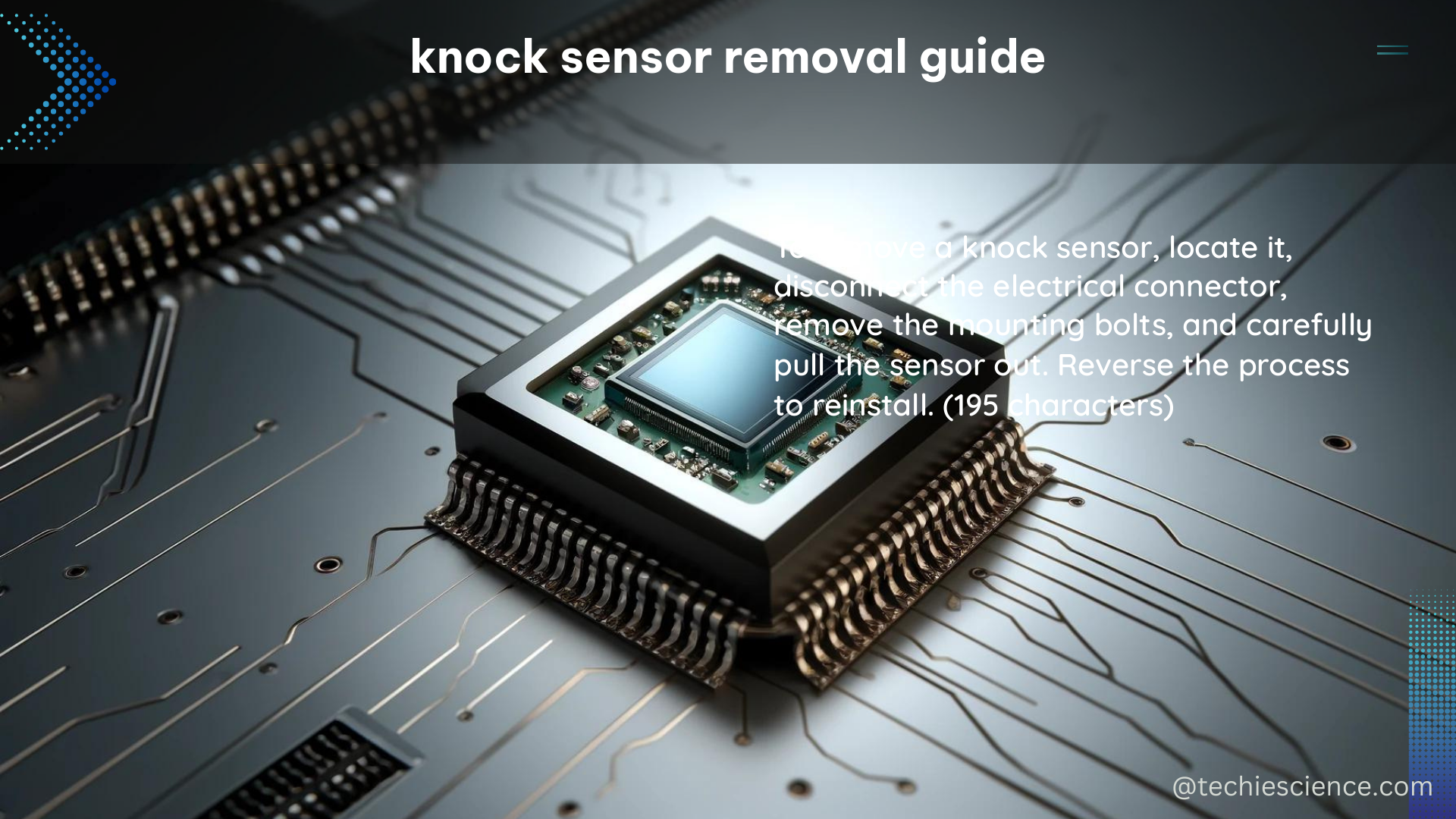The knock sensor is a critical component in an engine’s management system, responsible for detecting engine knock or pinging, which can cause severe engine damage if left unchecked. This sensor, typically a piezoelectric crystal, oscillates in proportion to engine vibration, producing a voltage output that the Powertrain Control Module (PCM) monitors. When the oscillation exceeds a certain threshold, the PCM retards the ignition timing to prevent engine knock.
Necessary Tools and Equipment
Removing a knock sensor requires a specific set of tools, including:
- 10mm and 12mm sockets
- Long socket extension bar
- Torque wrench capable of 24Nm (17.7 ft-lb) of torque
- Radiator hose remover
- Ample illumination, such as a work light or flashlight
- Magnetic dropped-parts retriever
- Fender guards to protect the vehicle’s paint
- Tools for removing the intercooler and small coolant hoses (if applicable)
Locating the Knock Sensor

The knock sensor is typically located on the top of the engine block, at the back, in the vicinity of cylinder 4, and under the inside edge of the throttle body. The exact location may vary depending on the make, model, and engine configuration of the vehicle.
Knock Sensor Removal Procedure
-
Prepare the Work Area: Ensure the work area is clean and well-lit. Install fender guards to protect the vehicle’s paint from any potential scratches or damage.
-
Disconnect the Battery: Disconnect the negative (-) battery cable to prevent any electrical issues during the removal process.
-
Access the Knock Sensor: Depending on the vehicle, you may need to remove the intercooler, small coolant hoses, or other components to gain access to the knock sensor. Refer to your vehicle’s service manual for specific instructions.
-
Disconnect the Knock Sensor Electrical Connector: Locate the knock sensor electrical connector and carefully disconnect it. Avoid pulling on the wires, as this can damage the connector or the wiring harness.
-
Remove the Knock Sensor Bolt: Using a 12mm socket and a torque wrench, loosen and remove the knock sensor bolt. The torque specification for a Subaru EJ25 turbo engine is 24Nm (17.7 ft-lb). Ensure you use the correct torque specification to prevent damage to the sensor or engine.
-
Extract the Knock Sensor: Gently pull the knock sensor out of its mounting location. If the sensor is stuck, use a small pry bar or a magnet to carefully remove it.
-
Inspect the Mounting Surface: Examine the mounting surface for any debris, corrosion, or damage. Clean the surface with a soft wire brush or emery cloth if necessary.
-
Install the New Knock Sensor: Carefully insert the new knock sensor into the mounting location, ensuring it is properly aligned. Thread the knock sensor bolt by hand to avoid cross-threading.
-
Tighten the Knock Sensor Bolt: Using a torque wrench, tighten the knock sensor bolt to the specified torque. For the Subaru EJ25 turbo engine, the torque specification is 24Nm (17.7 ft-lb).
-
Reconnect the Electrical Connector: Reconnect the knock sensor electrical connector, ensuring it clicks into place securely.
-
Reinstall Removed Components: If you had to remove any components to access the knock sensor, carefully reinstall them, following the reverse order of disassembly.
-
Reconnect the Battery: Reconnect the negative (-) battery cable.
-
Verify Proper Operation: Start the engine and check for any warning lights or diagnostic trouble codes related to the knock sensor. If everything appears to be functioning correctly, the job is complete.
Troubleshooting and Considerations
-
In some cases, a knock sensor may fail due to water intrusion or other issues. For example, a 2004 GMC Sierra 1500 with the 5.3 engine may experience knock sensor issues if the sensor is exposed to water or other contaminants. In such cases, it’s important to replace the sensor and harness with OEM parts and ensure a good seal to prevent future issues.
-
In some instances, it may be possible to tune out the knock sensors if they are missing or malfunctioning. However, this requires careful tuning to prevent the system from becoming confused and randomly indicating max knock, which can cause the engine to pull timing and lose power.
-
Failing to use the correct torque specifications can lead to engine knock or other issues. Always refer to the manufacturer’s recommendations and use a torque wrench to ensure the knock sensor is properly installed.
By following this comprehensive guide, you can successfully remove and replace a knock sensor on your vehicle, ensuring proper engine operation and preventing potential damage.
Reference:
1. Knock Sensor Removal Guide
2. Knock Sensor P0327 P0332 Issue
3. Knock Sensor Delete Advisable?

The lambdageeks.com Core SME Team is a group of experienced subject matter experts from diverse scientific and technical fields including Physics, Chemistry, Technology,Electronics & Electrical Engineering, Automotive, Mechanical Engineering. Our team collaborates to create high-quality, well-researched articles on a wide range of science and technology topics for the lambdageeks.com website.
All Our Senior SME are having more than 7 Years of experience in the respective fields . They are either Working Industry Professionals or assocaited With different Universities. Refer Our Authors Page to get to know About our Core SMEs.